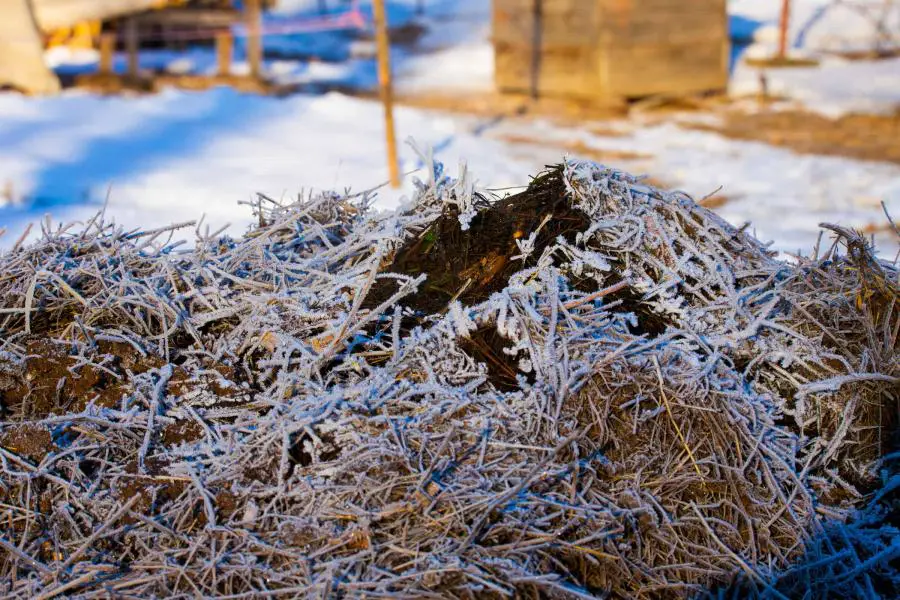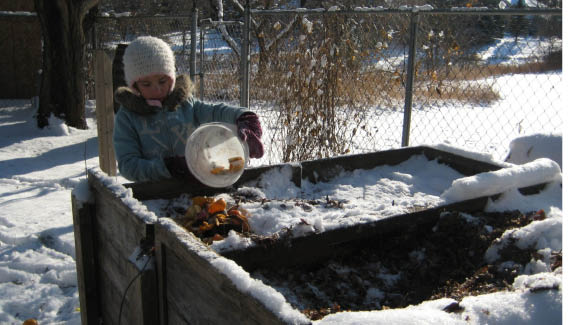Before a hard freeze dig a hole in the pile and fill it with dr. Temperatures between 90 degrees Fahrenheit and 140 degrees Fahrenheit indicate rapid decomposition.

Bamboozle Graphite Composter Reviews Crate And Barrel Compost Bin Kitchen Compost Bin Modern Compost Bins
The temperature is usually felt by the worms as soon as it goes below 57 degrees Fahrenheit.

Composting in winter canada. Harvesting the compost before starting your winter compost heap will free up space for the new compost. But composting doesnt have to come to a full-stop during the cold months. If your winter is long like mine the volume of food scraps is.
Collect leaves in the fall and store under cover for composting use throughout winter. Short cold days allow conditions inside your compost piles to cool down to almost nothing. While heat is a by-product of the chemical process that is occurring warm weather does help to speed decomposition and cold weather will slow or even stop it.
Work on Your Ratio. The supply of compostable materials from your landscape falls off once the leaves are raked and the freeze is on. Basic Requirements for Winter Composting.
Keeping the bin warm is important if you live in an area that has harsh winter. Its a smart idea to stockpile and collect all of the leaves you can throughout the fall. Use the compost around your garden in your raised beds or transfer to a dry container with a lid for use in the spring.
To start a leaf compost pile gather together the leaves and layer with dirt. Even if they are not consumed by worms right away larger amounts of fresh nitrogen rich food like most kitchen scraps can heat up easily and in fact can be a source of heat even in winter. When temperatures rise above freezing the process resumes.
This brief video shows how fast your winter compost can come back up to temperature once you turn material back in and re-wet the pile. Use one layer of dirt for each foot of leaves. Winter traditionally puts a chill on composting.
That way the composting keeps going. Your winter compost needs brown materials to stay active but its hard to find good sources in the winter. Winter vermicomposting is doable just as long as you know how to give extra care for your red wigglers needs.
Temperature is a crucial factor in the winter composting process. As long as your compost is kept above freezing it continues to work slowly through the winter. Keep a winter compost pile in a sunny location and it may stay thawed and active all winter.
That gives you a brown composting material all winter long. During the winter your red wigglers will start feeling the cold temperature as soon as the worm bin starts to absorb the wintry weather. You can bag up leaves in black trash bags to keep them over the winter.
A frozen heap or even one with temperatures just above the freezing mark wont do you much good. Larger worm farm designs can still take in vegetable scraps over winter. There are a number of ways that you can help to keep some heat in your compost pile during the winter to prevent decomposition from stopping.
The Compost Quality Alliance CQA is a voluntary program established by the Compost Council of Canada and the compost producers utilizing standardized testing methodologies and uniform operating protocols to improve customer confidence in compost selection and utilization. In the coldest weather the process simply stalls and the food scraps freeze. Winter composting is like summer composting but in slow motion.
Novice composters may want to track temperatures. If vermicomposting in cold weather you should also manage your expectations and understand the worms simply likely wont process your waste as consistently or reproduce as well if your bin is kept in an area subject to the low temperatures and low humidity that come with winter. During the winter months decomposition will be slower but will quickly resume as temperatures rise in the spring.
It is best to empty compost bins of all usable compost prior to the onset of winter. Volume helps to generate heat. Municipal nonprofit organization Green Calgary in Alberta Canada where winter temperatures can drop.
The pile should be about 4ft in diameter and 3ft deep. In order to compost successfuly all winter long you need to make sure that your system stays microbially active.

Conseil Canadien Du Compost Compost Around The Worlds Edible Garden

Compost At No Cost Under 3 Weeks Youtube Garden Compost How To Make Compost How To Dry Basil

Winter Composting How To Compost Food Scraps Yard Waste In Cold Climates Winter Vegetables Gardening Compost Worm Composting

Easy Winter Composting In A Cold Climate Empress Of Dirt

How To Compost During The Winter Months

Easy Winter Composting In A Cold Climate Empress Of Dirt

Michigan Gardener Manure Composting Horse Manure Composting Compost

How To Compost When Its Freezing Outside Shifting Roots

How To Compost When Its Freezing Outside Shifting Roots
Https Albertacare Org Images Stories Powerpoint Compostingpresentation Pdf

Backyard Mini Compost Topper Compost Spreader Made In Canada The Bannerman Mini Compost Topper Spreader Quic Compost Sustainable Garden Deck Landscaping

Van Life Canada Working From The Road Ray Outfitted Van Life Van Rv Water Tank

Composting In Winter Ultimate Guide To Hot Compost

The Beginner S Guide To Composting The Easy Way Compost Grass Clippings Organic Gardening

Pin By Adele On Gardening Rhubarb Plants Plant Care Healthy Plants

Easy Winter Composting In A Cold Climate Empress Of Dirt

Center Of The Humanure Composting Universe Composting Toilets Treehouse Masters Tree House


